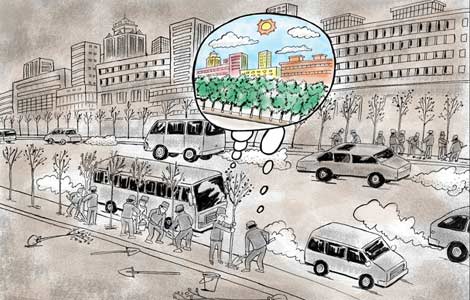Relaxed rules give dreams of flying new hope
Updated: 2014-02-05 01:00
By Zhao Lei (China Daily)
|
|||||||||||
More support urged
To simplify procedures, the government specified in December that general aviation aircraft only need to apply for flight approval under certain situations including entering or exiting Chinese territories, flying through restricted zones or conducting aerial photography or surveys of military facilities.
General aviation typically refers to privately owned — and often business-related — aircraft, as opposed to commercial airliners or military planes.
Therefore, flights outside the specified criteria only need to obtain airspace-use authorization before takeoff.
Meng Ping, head of the administration's national defense mobilization, said the move fulfills the government's pledge to reform administrative procedures and clarifies the roles of the civil aviation departments and the military in managing general aviation flights.
The policy shift makes it easier for private aircraft owners and pilots to use their planes, but it is still far from enough to meet the needs of the general aviation industry's development, Zhang Feng, secretary-general of Aircraft Owners and Pilots Association of China, told Xinhua News Agency.
"Our country has yet to make an aeronautical chart for low-altitude airspace," he said.
"There are no regulations or authorities governing private aircraft registration. Owners of these aircraft have to register their planes or helicopters with airlines. It is also difficult to insure private aircraft in China now."
Wu Guanghui, deputy general manager of Commercial Aircraft Corp of China, said: "China's overall air transportation turnover is ranked as the second-largest in the world, preceded only by the United States. But in the civil aviation sector, we are only a big, but not strong, air transporter."
He emphasized that there are more than 300,000 general aviation aircraft in the US and less than 2,000 in China.
Meanwhile, the US has more than 30,000 airports that can handle general aviation aircraft travel, but China has just 182.
Gao Yuanyang, director of Beihang University's General Aviation Industry Research Center, said although the government has been gradually improving its policies and management, a degree of caution is still needed toward the industry's prospects.
"The sector's rapid growth, which has been anticipated by many people, is far from occurring," he said. "The industry is still being hindered by the absence of specific policies, a lack of professionals and facilities, unbalanced allocation of airports and outdated management."
The government should encourage the establishment of more airports dedicated to servicing general aviation aircraft, flight service stations and training agencies, Gao said.
By June, there were 1,610 general aviation aircraft, and the number is expected to rise to 10,000 by 2020. More than 110 cities are building or planning to establish an industry park dedicated to general aviation, Xinhua reported.
Zhang from the Aircraft Owners and Pilots Association of China said the country has more than 10 million square kilometers of airspace and investment in the general aviation sector will generate 10 times that in revenue, adding each job in the sector can create 12 jobs in other industries.
Related Stories
China prepares for take-off of business aviation market 2012-03-29 14:35
Aircraft sales to shoot skyward 2011-04-18 11:26
Airbus sees huge potential in China in private aviation 2008-02-14 09:46
Take to the skies for just $2,300 2007-05-10 06:56
Today's Top News
Non-manufacturing PMI drops in January
WeChat cash gifts popular
Navy starts West Pacific drill
Women driving e-shopping
Police capture shooting spree fugitive
Xi extends Lunar New Year greetings
London goes all-out to ring in Lunar New Year
Chinese family infected with H7N9
Hot Topics
Lunar probe , China growth forecasts, Emission rules get tougher, China seen through 'colored lens', International board,
Editor's Picks

|

|

|

|

|

|





